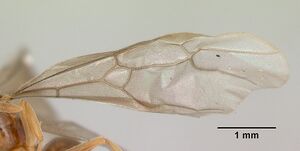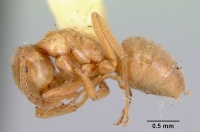Lasius pubescens
| Lasius pubescens | |
|---|---|

| |
| Scientific classification | |
| Kingdom: | Animalia |
| Phylum: | Arthropoda |
| Class: | Insecta |
| Order: | Hymenoptera |
| Family: | Formicidae |
| Subfamily: | Formicinae |
| Tribe: | Lasiini |
| Genus: | Lasius |
| Section: | flavus clade |
| Species group: | claviger |
| Species: | L. pubescens |
| Binomial name | |
| Lasius pubescens Buren, 1942 | |
| At a Glance | • Temporary parasite |
Identification
Worker: Similar to Lasius bureni, but SI 83 or more. Erect petiolar scale with crest below level of propodeal spiracles; blunt, not emarginate. Standing hairs on gula measuring 0.10 mm or less, those on crest of scale usually numbering 2, one on each corner. Pubescence short, dense over most of body. Averaging and ranging smaller than bureni. Color yellow to brownish yellow. Queen: Similar to bureni. Crest of erect petiolar scale below level of prodpodeal spiracle, blunt to very blunt, without emargination; sides slightly convex. Standing body hairs less numerous and shorter than in bureni. Standing hairs on crest and sides of scale and on gula each numbering 6 or less, with a maximum length not over 0.12 mm; those on fore femur numbering about 6, with a maximum length not over 0.08 mm. Alitrunk with longer standing hairs measuring 0.20 mm or less. Antennal scapes longer, SI 77-78. Body size smaller, HW 1.10 mm or less. Pubescence on dorsum of gaster very dense. Body color deep grayish brown, appendages lighter. Pubescence denser on gaster than elsewhere on body, fairly sparse on alitrunk. Declivitous face of propodeum below spiracles highly glabrous. (Wing 1968)
Keys including this Species
- Key to Lasius-Nearctic Acanthomyops workers
- Key to Lasius-Nearctic Acanthomyops queens
- Key to North American Lasius Species
Distribution
Known from Minnesota and Tennessee.
Latitudinal Distribution Pattern
Latitudinal Range: 46.24° to 36.06016°.
| North Temperate |
North Subtropical |
Tropical | South Subtropical |
South Temperate |
- Source: AntMaps
Distribution based on Regional Taxon Lists
Nearctic Region: United States (type locality).
Distribution based on AntMaps
Distribution based on AntWeb specimens
Check data from AntWeb
Countries Occupied
| Number of countries occupied by this species based on AntWiki Regional Taxon Lists. In general, fewer countries occupied indicates a narrower range, while more countries indicates a more widespread species. |

|
Estimated Abundance
| Relative abundance based on number of AntMaps records per species (this species within the purple bar). Fewer records (to the left) indicates a less abundant/encountered species while more records (to the right) indicates more abundant/encountered species. |

|
Biology
Wing (1968) – I collected a colony near McGrath, Aitkin Co., Minnesota on August 29, 1950. It was a populous colony in a low mound in open woods. The type series was collected by W. F. Buren on August 11, 1941, near Jenkins, Crow Wing Co., Minnesota. This colony also was nesting in a sandy, low mound in open woods. The Buren nest series had only 4 queens and no males. He took this to indicate that all major flight activity had occurred before the collection date, August 11, 1941.
This species is likely to be a temporary parasite, but its host is unknown.
Castes
Queen
Images from AntWeb
   
| |
| Paratype of Lasius pubescens. Queen (alate/dealate). Specimen code casent0103495. Photographer April Nobile, uploaded by California Academy of Sciences. | Owned by USNM, Washington, DC, USA. |
Nomenclature
The following information is derived from Barry Bolton's Online Catalogue of the Ants of the World.
- pubescens. Lasius (Acanthomyops) pubescens Buren, 1942: 405 (w.q.) U.S.A. Combination in Acanthomyops: Creighton, 1950a: 433; in Lasius: Ward, 2005: 13. See also: Wing, 1968: 138.
Description
Worker
Type Material
Wing (1968) - Type locality: Jenkins, Crow Wing Co., Minnesota. Location of types: Holotype queen in the W. F. Buren Collection; paratypes in the collections of the Museum of Comparative Zoology, National Museum of Natural History and Iowa State College.
References
- Bolton, B. 1995b. A new general catalogue of the ants of the world. Cambridge, Mass.: Harvard University Press, 504 pp. (page 53, catalogue)
- Buren, W. F. 1942. New ants from Minnesota, Iowa, and Wisconsin. Iowa State Coll. J. Sci. 16: 399-408 (page 405, worker, queen described)
- Creighton, W. S. 1950a. The ants of North America. Bulletin of the Museum of Comparative Zoology 104: 1-585 (page 433, Combination in Acanthomyops)
- Ward, P.S. 2005. A synoptic review of the ants of California (Hymenoptera: Formicidae). Zootaxa 936: 1-68 (page 13, revived combination in Lasius (Acanthomyops))
- Wing, M. W. 1968a. Taxonomic revision of the Nearctic genus Acanthomyops (Hymenoptera: Formicidae). Mem. Cornell Univ. Agric. Exp. Stn. 405: 1-173 (page 138, see also)
References based on Global Ant Biodiversity Informatics
- Wing M. W. 1968. Taxonomic revision of the Nearctic genus Acanthomyops (Hymenoptera: Formicidae). Memoirs of the Cornell University Agricultural Experiment Station 405: 1-173.


